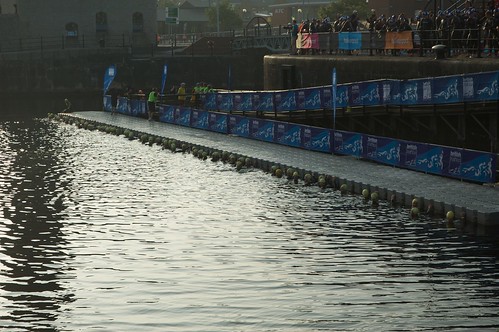
As a triathlete I’m selfish. I’m well organised, manage my time well, train hard, get the hours in, do lots of stuff with my family and work hard (at work). But nonetheless to do what I do I have to focus this stuff around me. Racing is about me and my performance. Training is about preparing myself for race day. The idea of doing all this for another person is a bit of a weird idea for many triathletes, but when the idea of guiding a visually impaired triathlete was mooted it sounded like a challenge. At the base of it, what I do is about challenge so why not make it harder and do something new: try to guide another athlete to his best performance? I find it difficult to say “no” when someone suggests something new, difficult and interesting.
Sean and I both raced at the Llanelli triathlon and paratriathlon weekend. It’s just down the road from me so I popped down to watch him and his current guide Owen race to find out what is involved. It’s quite technical, with new rules and methods for guiding in the swim and the run, and logistical stuff to consider in transition. Getting on and off a tandem is a skill in itself, and not something I’ve done for years. Once on the tandem guiding is simple (I sit on the front, shout out upcoming turns and get to pedal really hard).
Sean and I got some practice in when he visited the Gower. Swimming works well, lashed together at the thighs, as we’re used to drafting in the water. He’s a faster swimmer than me but I get a good draft off him at his shoulder so together we swim faster than I do alone. I swim on his left and he can kind of see my hat as he breathes. If I guide to the left the elastic pulls on him, and to tend to the right I swat the back of his head. To turn right I punch him in the back. Easy. Apart from the swimming as fast as I can bit.
At the European Championships I spent time watching the transition methods of the upper echelon visually impaired athletes. One pair did the slickest tandem flying mount you’ll ever see, and a Spanish pair lost a shoe after the mount line leading to early chaos and near disaster. Communication, planning and rehearsal are the keys here, I feel. Prepare for the expected and the unexpected. Getting out of T1 may be the hardest thing we do.
Riding the tandem is great and annoying in unequal portions. When you spend a big part of your life riding a bike on your own sharing that with someone else tied to you by a chain that affects when you pedal and freewheel, stops you from getting out of the saddle, makes you think really hard about corners and makes last second braking terrifying is an awkward experience. Adding another few hundred watts to the back is brilliant though. It’s fast and scary. I don’t know how people ride from John O’Groats to Land’s End like this.
Running with Sean is easier, and when we practiced together I found that I have to pay attention to the surface and keep him updated when it’s uneven more than keep us straight. This bit should be ok but we’ll see what happens after I’ve melted my legs on the bike and my brain is struggling to think. As long as we have Sean’s lucky rope we should be good.
I’m looking forward to it and I’ve had some good form in the middle of the season. It is worrying to have someone else’s race in your hands particularly when paratriathletes don’t get many opportunities to compete. I can make a mess of my own races in places but usually pull through. I feel that could be amplified when guiding a visually impaired athlete. Sean has a fairly relaxed attitude but it’s clear that he wants to win. We’ll go fast!
This entry will also appear on the Welsh Triathlon website after the race. Read the first part from Sean’s perspective here:
http://www.welshtriathlon.org/news/paratriathlon_sean_grundy_4572